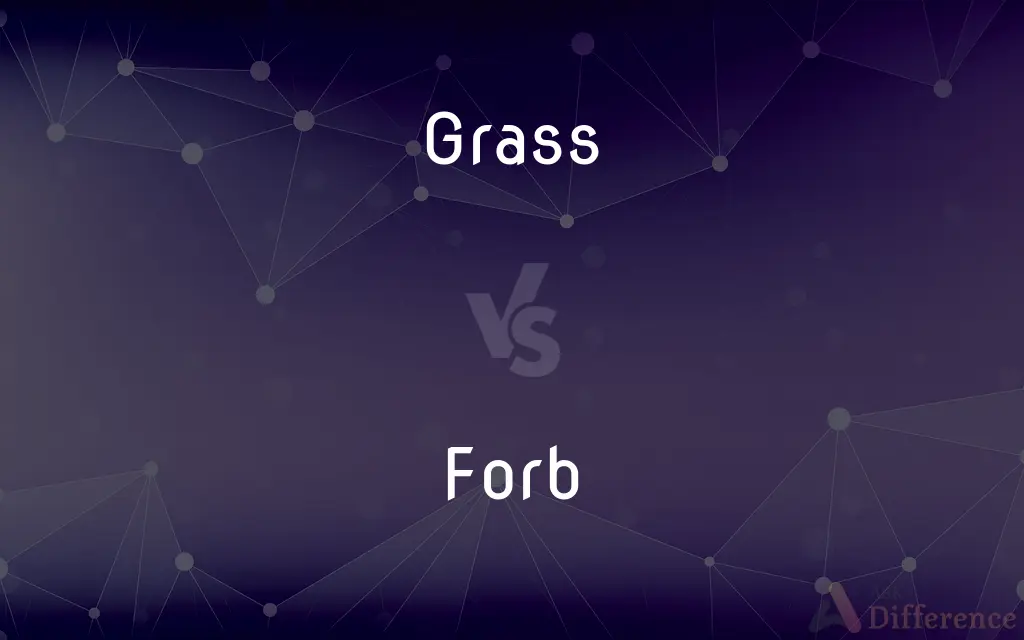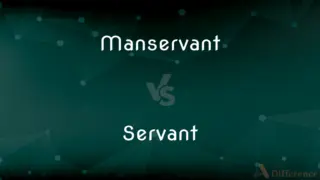Grass vs. Forb — What's the Difference?
Edited by Tayyaba Rehman — By Urooj Arif — Updated on March 26, 2024
Grass is a family of plants known for narrow leaves and growth from the base, while forbs are broad-leaved herbs other than grasses.

Difference Between Grass and Forb
Table of Contents
ADVERTISEMENT
Key Differences
Grasses are part of the Poaceae family, characterized by their narrow leaves and growth from the base. These plants are crucial for ecosystems, providing food for many animals and materials for human use. Whereas forbs, which belong to various plant families, are broad-leaved herbs not classified as grasses, trees, or shrubs. Forbs are diverse in their habitats and forms, contributing significantly to the biodiversity of prairies, meadows, and forests.
Grasses reproduce through seeds and have a unique flowering structure called an inflorescence, which can be a spike, raceme, or panicle, depending on the species. This reproductive strategy allows grasses to spread effectively and adapt to various environments. On the other hand, forbs exhibit a wide range of flowering structures and reproduction methods, including distinct flowers that can be solitary or part of an inflorescence. Forbs' flowers are often colorful and designed to attract pollinators, a key difference from the more wind-pollinated grasses.
The root systems of grasses are typically fibrous, spreading out to form a dense network that helps prevent soil erosion and supports the soil structure. This root system is advantageous in nutrient-poor soils and helps grasslands recover from disturbances like fire. Conversely, forbs can have either fibrous or taproot systems, with some species developing deep roots that tap into underground water sources, making them resilient in different environmental conditions and contributing to their varied habitats.
Grasses are often perennial, living for multiple years and regrowing each season from the same root system, which allows them to dominate many landscapes around the world. They have evolved to withstand grazing and mowing, which can actually stimulate their growth. Forbs, while also including perennials, encompass a broader range of life cycles, including annuals and biennials, which enables them to colonize and thrive in disturbed or transitional areas where grasses might not be as competitive.
In human culture, grasses have immense economic importance, with crops like wheat, maize, and rice being staples of the global diet. Grasses are also used in landscaping, sports fields, and as biofuel sources. Forbs, though not as universally crucial to agriculture, hold value in horticulture for their aesthetic appeal and are vital in traditional medicine and as sources of nectar for bees and other pollinators, highlighting the interconnectedness of human and natural ecosystems.
ADVERTISEMENT
Comparison Chart
Leaf Shape
Narrow, often linear
Broad, varied shapes
Habitat
Wide range, including savannas and temperate forests
Diverse, from prairies to forests
Reproductive Structure
Inflorescences like spikes, racemes
Diverse flowers, often colorful
Root System
Mainly fibrous, dense network
Fibrous or taproot, varied depth
Importance to Humans
Essential for agriculture, landscaping
Horticultural value, traditional medicine
Compare with Definitions
Grass
A plant of the Poaceae family with narrow leaves.
Wheat is a type of grass grown for its seeds.
Forb
A broad-leaved herb not classified as grass, tree, or shrub.
Dandelions are forbs commonly found in lawns.
Grass
Grows from the base, enabling it to recover from grazing.
Grass lawns are mowed regularly to keep them dense and healthy.
Forb
Exhibits a wide range of flowering structures.
The meadow was dotted with the colorful flowers of various forbs.
Grass
Reproduces through seeds in inflorescences.
The grass in the field bloomed with tiny flowers on spikes.
Forb
Can have fibrous or taproot systems.
Some forbs have deep roots that access water from below the surface.
Grass
Has a fibrous root system.
The grass’s roots held the soil firmly, preventing erosion.
Forb
Includes annuals, perennials, and biennials.
Many forbs in the prairie bloom beautifully in their first year.
Grass
Used in various human activities.
Grasses like bamboo are utilized in construction and crafts.
Forb
Provides nectar for pollinators and has medicinal uses.
Echinacea, a forb, is widely used in herbal remedies.
Grass
A member of the grass family.
Forb
A forb or phorb is a herbaceous flowering plant that is not a graminoid (grass, sedge, or rush). The term is used in biology and in vegetation ecology, especially in relation to grasslands and understory.
Grass
The members of the grass family considered as a group.
Forb
A broad-leaved herb other than a grass, especially one growing in a field, prairie, or meadow.
Grass
Any of various plants having slender leaves similar to those of a grass.
Forb
Any non-woody flowering plant that is not a graminoid (a grass, sedge, or rush).
Grass
Ground, as on a lawn, that is covered with grass or similar plants.
Grass
Grazing land; pasture.
Grass
(Slang) Marijuana.
Grass
(Electronics) Small variations in amplitude of an oscilloscope display caused by electrical noise.
Grass
Chiefly British Slang An informer.
Grass
To cover with grass.
Grass
To grow grass on.
Grass
To feed (livestock) with grass.
Grass
To become covered with grass.
Grass
To graze.
Grass
Any plant of the family Poaceae, characterized by leaves that arise from nodes in the stem and leaf bases that wrap around the stem, especially those grown as ground cover rather than for grain.
Grass
(countable) Various plants not in family Poaceae that resemble grasses.
Grass
(uncountable) A lawn.
Grass
Marijuana.
Grass
An informer, police informer; one who betrays a group (of criminals, etc) to the authorities.
What just happened must remain secret. Don't be a grass.
Grass
Sharp, closely spaced discontinuities in the trace of a cathode-ray tube, produced by random interference.
Grass
Noise on an A-scope or similar type of radar display.
Grass
The season of fresh grass; spring or summer.
Grass
That which is transitory.
Grass
Asparagus; "sparrowgrass".
Grass
(mining) The surface of a mine.
Grass
(transitive) To lay out on the grass; to knock down (an opponent etc.).
Grass
To act as a grass or informer, to betray; to report on (criminals etc) to the authorities.
Thesaurus:rat out
Grass
(transitive) To cover with grass or with turf.
Grass
(transitive) To feed with grass.
Grass
(transitive) To expose, as flax, on the grass for bleaching, etc.
Grass
(transitive) To bring to the grass or ground; to land.
Grass
Popularly: Herbage; the plants which constitute the food of cattle and other beasts; pasture.
Grass
An endogenous plant having simple leaves, a stem generally jointed and tubular, the husks or glumes in pairs, and the seed single.
Grass
The season of fresh grass; spring.
Two years old next grass.
Grass
Metaphorically used for what is transitory.
Surely the people is grass.
Grass
Marijuana.
Grass
To cover with grass or with turf.
Grass
To expose, as flax, on the grass for bleaching, etc.
Grass
To bring to the grass or ground; to land; as, to grass a fish.
Grass
To produce grass.
Grass
Narrow-leaved green herbage: grown as lawns; used as pasture for grazing animals; cut and dried as hay
Grass
German writer of novels and poetry and plays (born 1927)
Grass
Animal food for browsing or grazing
Grass
Street names for marijuana
Grass
Shoot down, of birds
Grass
Cover with grass;
The owners decided to grass their property
Grass
Spread out clothes on the grass to let it dry and bleach
Grass
Cover with grass
Grass
Feed with grass
Grass
Give away information about somebody;
He told on his classmate who had cheated on the exam
Common Curiosities
Are all grasses perennials?
Many grasses are perennials, but there are also annual and biennial species.
What distinguishes a grass from a forb?
Grasses have narrow leaves and grow from their base, while forbs have broad leaves and diverse flowering structures.
How do grasses contribute to soil health?
Their fibrous root systems help prevent erosion and maintain soil structure.
Do grasses need a lot of water to grow?
Grasses vary in their water needs; some are very drought-tolerant, while others require more moisture.
Are all forbs beneficial to pollinators?
While not all, many forbs are important for pollinators due to their flowers.
Why are grasses important in agriculture?
Grasses like wheat, maize, and rice are staple food crops worldwide.
Can forbs be found in grasslands?
Yes, forbs often grow in grasslands, adding to the biodiversity and providing food for wildlife.
How do forbs adapt to different environments?
Forbs adapt through diverse root systems and life cycles, thriving in various habitats.
Are forbs considered weeds?
Some forbs are considered weeds in certain contexts, although many are valued for their ecological roles.
How do forbs benefit wildlife?
They provide food and habitat for various animals, including pollinators and herbivores.
Do grasses have flowers?
Yes, grasses flower, but their inflorescences are often less conspicuous than those of forbs.
What role do grasses play in preventing soil erosion?
Their dense, fibrous root networks help hold soil in place, reducing erosion.
Can forbs be used for landscaping?
Yes, forbs are often used in gardens and landscapes for their aesthetic appeal.
How do grasses and forbs reproduce?
Grasses reproduce through seeds in inflorescences, while forbs can have various reproductive structures.
Can grasses grow in shaded areas?
While many prefer full sun, some grass species are adapted to grow in shaded environments.
Share Your Discovery

Previous Comparison
Drag vs. Lug
Next Comparison
Manservant vs. ServantAuthor Spotlight
Written by
Urooj ArifUrooj is a skilled content writer at Ask Difference, known for her exceptional ability to simplify complex topics into engaging and informative content. With a passion for research and a flair for clear, concise writing, she consistently delivers articles that resonate with our diverse audience.
Edited by
Tayyaba RehmanTayyaba Rehman is a distinguished writer, currently serving as a primary contributor to askdifference.com. As a researcher in semantics and etymology, Tayyaba's passion for the complexity of languages and their distinctions has found a perfect home on the platform. Tayyaba delves into the intricacies of language, distinguishing between commonly confused words and phrases, thereby providing clarity for readers worldwide.














































